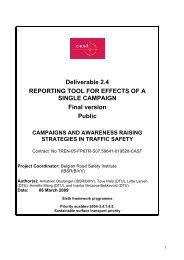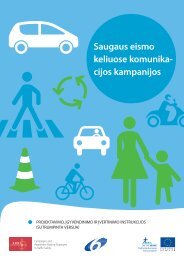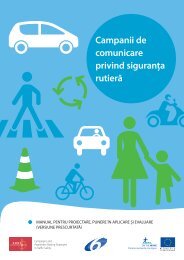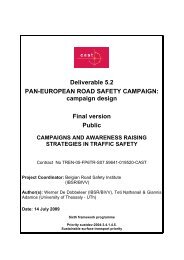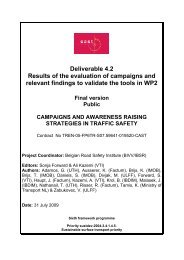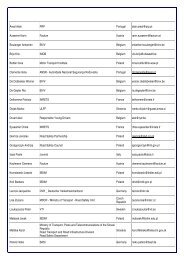Deliverable D 1.3 RESULTS OF META-ANALYSIS ... - cast-eu.org
Deliverable D 1.3 RESULTS OF META-ANALYSIS ... - cast-eu.org
Deliverable D 1.3 RESULTS OF META-ANALYSIS ... - cast-eu.org
You also want an ePaper? Increase the reach of your titles
YUMPU automatically turns print PDFs into web optimized ePapers that Google loves.
Campaigns and awareness raising strategies in traffic safety — <strong>Deliverable</strong> D-1.1use of other people as channels for the delivery of the campaign messageimplies that an increased level of intimacy with the target could be important,possibly because it increases the likelihood that the target attends andprocesses the campaign message (Vaa et al., 2004; also see Work Package<strong>Deliverable</strong> 1.4).According to multivariate models, on-road delivery is also positivelyassociated with campaign effects, on both accidents and seatbelt use. Onroaddelivery involves the use of billboards, or other fixed or variable messagesigns placed at the side of the road. This suggests that delivery of themessage to drivers at a place that is in terms of space and time proximal tothe target behaviour is beneficial in terms of campaign effect. In other words,achieving immediacy in the delivery of a campaign message might beimportant.In terms of accident counts, short campaign duration is also beneficialaccording to multivariate analyses, and this also implies a sense ofimmediacy. In shorter, more intense campaigns, the message may be morelikely to be received at a time that is proximal to carrying out of the targetbehaviour.Taken together, intimacy and immediacy suggest that those campaigns thatmake the target person think carefully about the message in the context of thedriving behaviour would tend to be more successful at achieving effects duringor after the campaign. In this light, it is interesting to consider that the carryingout of campaigns in a limited area, such as an <strong>org</strong>anisation or car park, waspositively associated with improvements in seatbelt use, since suchcampaigns would presumably be more likely to use personal communicationand deliver the message to the driver at a time that is proximal in space andtime to the context of the targeted driving behaviour.But mass media methods are still importantLack of evidence linking mass-media methods such as television or radio toimprovements in campaign effects (whether accident counts or seatbelt use isthe outcome measured) is in line with the idea that intimacy and immediacyare beneficial to campaign outcomes. To this we can add those findings frombivariate analysis that selection for campaigns using mass-media results ineither the same or reduced overall effects, across several behaviouraloutcome measures. While we cannot conclude from bivariate analyses thatuse of mass-media has less effect at the local level, than at regional ornational levels, it does seem that within a small area, where a much morefocused campaign is possible, those methods which are difficult to carry outon a larger scale (e.g. rewards, pledge cards) are particularly effective andtherefore worth considering.Targets receive campaign messages delivered by television or newspapers inways that are often removed in space and time from the actual (on-road)target behaviour. These targets would also often be in a situation in which it iseasy to ‘switch off’ or ignore the campaign message. Despite this, werecommend that campaign designers continue to consider mass-media for thefollowing reasons.113



